Robertsbridge Abbey
Robertsbridge Codex New discovery 2008 New discovery 2012 New discovery 2021 In Search of an Abbey
The Cistercian abbey at Robertsbridge was founded in 1176 by Robert de St. Martin or by his near kinsman Alvred de St. Martin, Sheriff of Hastings and ‘dapifer' (Steward to the Royal household) to King Richard I. The abbey, the only Cistercian abbey in Sussex , was settled by monks from the mother abbey of Boxley in Kent . They were known as the white monks because of their use of undyed wool for their habits.
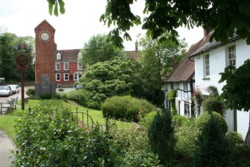
Originally the abbey was founded on a site believed to be close to the present war memorial and the medieval house called St. Catherine’s and where once there was a spring known as St. Catherine’s well.
It was probably only a small chapel but the abbey received many gifts and endowments from benefactors, in particular the Bodiam and Etchingham families and perhaps as a consequence of their increased wealth, the monks built a new abbey about 1 mile east of the original site starting about 1210 AD. That an earlier building existed is shown by a charter of 1314 which refers to 'the chapel on the spot where the abbey was originally founded'.

View of building at Robertsbridge Abbey - Copper plate engraving from The Antiquities of England and Wales by Francis Grose c. 1787
In the early years of its existence, the abbey played some considerable part in the history of England , the abbot being sent with the abbot of Boxley in 1192 to search for King Richard who was being held hostage in Bavaria on his return from the Crusades. Having found him, they were sent back to England to raise his ransom. The same two abbots in 1198 acted as agents for the Archbishop of Canterbury to the Pope over a quarrel with the monks at Canterbury. In 1212 the abbot of Robertsbridge was again sent abroad as the king’s messenger and again in 1221 and 1225, in which year the king also paid a visit to the abbey.
However, most abbeys had usually only local fame and by the 1400s Robertsbridge seems to have faded, for in the Bodleian library there is a manuscript inscribed "This book belongs to St. Mary of Robertsbridge and whoever shall steal it or sell it, or in any way alienate it from this house or mutilate it let him be anathema maranatha". Beneath this is another note saying "I, John Bishop of Exeter, know not where the aforesaid house is, nor did I steal the book but acquired it in a lawful way".
The abbey records are incomplete but it appears to have had a good reputation and was frequently selected by monks who wanted to leave the Benedictine for the stricter Cistercian order.
The abbey escaped the first suppression of the Monasteries and survived until 16 April 1538 when the abbot and eight monks surrendered it. After the Dissolution, the abbey was acquired by Sir William Sidney, of Penshurst, and it stayed in the family until 1720. Considerable remains of the buildings survived until after 1783 when they were drawn by S.H. Grimm for Sir William Burrell but after that considerable destruction occurred.
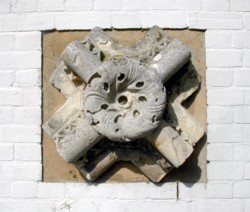
Several of the old houses in Robertsbridge incorporate stone and timber from the abbey, a carved boss can be seen built into the wall of the church rooms in Fair Lane and, in the 19th century parts were broken up and used for road repairs! What remains today is mostly the foundations and part of the abbot’s residence which is now a private house.
More information can be found at the Victoria County History web site.
Robertsbridge Codex
Very little of the records of the abbey were known about until the chance discovery of a large number, albeit incomplete, at Penshurst Place in the mid-19th century. Amongst these was a manuscripts which has been titled the ‘Robertsbridge Codex’ and in this were some sheets of music – these date from around 1360 and are the earliest known form of entabulated music. They were originally thought to be of Italian origin and perhaps brought back by one of the monks on their apparently frequent trips abroad but more recent assessment seems to indicate that they are English in origin.
The term codex, which usually refers to a manuscript book, is somewhat misleading as the musical section of the source comprises only two leaves, bound together with a larger manuscript. It contains six pieces, three of them in the form of the estampie, an Italian dance form of the 14th C., as well as three arrangements of motets, (a short piece of sacred choral music, typically polyphonic and unaccompanied). Two of the motets are from the Roman de Fauvel, a 14th-century French allegorical verse romance generally attributed to Gervais du Bus, a clerk at the French royal chancery. All the music is anonymous, and all is written in tablature, a form of musical notation indicating instrument fingering rather than musical pitches. Most of the music for the estampies is for two ‘voices’. It is most likely the instrument used to play the pieces in the Codex was a positive organ. The manuscript is in the British Library (MS 28550).
Click here for more information.
Use this link to hear a sample of this music played by Helen Ridout, a former Robertsbridge resident.
In 2021 new discoveries were made which added to the known fragments of the Codex.
Until recently, only two sources of Flos vernalis
were known: fragments of a vocal version in binding strips in All Souls
College, Oxford (MS 56); and its ornamented intabulation in the
so-called Robertsbridge MS. Two more concordances of the vocal version
have meanwhile been discovered, by Cristina Alís Raurich in Karlsruhe,
and in binding strips in Koblenz discovered by Karl Kügle. The new
findings allow a reconstruction of almost the entire piece, together
with evidence of an otherwise absent third voice. They permit an
analysis of the diminution, ornamentation and adaptation techniques in
the intabulation which can be related to theoretical texts of the
fourteenth century; Flos vernalis was more abundantly embellished than
the other intabulations in Robertsbridge. Several of the sources have
Cistercian connections.
An example of the newly discovered music can
be heard on this youtube recording.
The instrument in the video is called a clavicimbalum and was mostly used in the 15th century. In the 14th century Robertsbridge codex would most probably have been played on a positive organ. Unfortunately, no reconstructions of 14th century postiive organs exist at the moment.
New discovery 2008
In February 2008, Vince Butler and Damian Alger, working with metal detectors on a site near Wendling Abbey in Norfolk discovered a bronze seal matrix which they thought may have come from Robertsbridge Abbey. Vince Butler got in touch with me asking for more information about the abbey and has very kindly given me permission to show photographs of the object. These are shown below.
Also shown is a copy of the Robertsbridge Abbey Counter seal and the wording on this ends '...PONTE ROBT' - from the impression made with the seal from Norfolk, this appeared to be the same wording.
Another interesting coincidence is that Wendling Abbey was a Premonstratensian abbey as was our near neighbour Bayham.
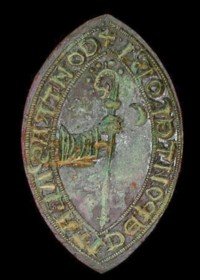
Bronze Matrix Seal measuring 41mm in length and 25mm wide.

Rear of Seal, showing where seal was affixed to something.

Impression made by seal .
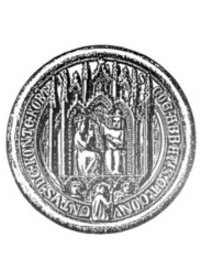
Robertsbridge Abbey Counter seal - note similarity of wording - 'PONTE ROBT'.
I put Vince in touch with Sussex Archaeological Society and he received the following reply from Christopher Whittick, Senior Archivist at East Sussex Record Office:
“This is a matrix for what is called a counter-seal, which is the image that is sometimes placed on the back of the piece of wax which carries on its face the corporate seal of the institution concerned. This is not quite the same as the great seal of a monarch or religious house, which has full-size images on both sides. Counter-seals are usually smaller than the one on the other face.
I have looked at the Victoria County History of Sussex volume 2 (1907) page 74 where the known seals of Robertsbridge are discussed (or perhaps I should say the ones which were known in 1907). There are two, a round one and a pointed oval or vesica-shaped one, which is illustrated in volume 8 of Sussex Archaeological Collections (1856) page 171.
The first, round one has two equal sides, and the second, pointed oval one has a counter-seal. The important news is that it is not your counter-seal, which is new!
The inscription on yours reads: + CONTRAS' ABATI DE PONTE ROB'I which can be expanded as: +CONTRASIGILLUM ABBATIS DE PONTE ROBERTI i.e. THE COUNTER SEAL OF THE ABBOT OF ROBERTSBRIDGE”
The Robertsbridge & District Archaeological Society, the Parish Council and some private benefactors pledged money to Sussex Past to enable them to try to buy this Seal and bring it into the museum at Lewes. Unfortunately, their bid was unsuccessful and it was bought by Norwich Castle Museum and will go on public display there at some time in the future.
New discovery 2012
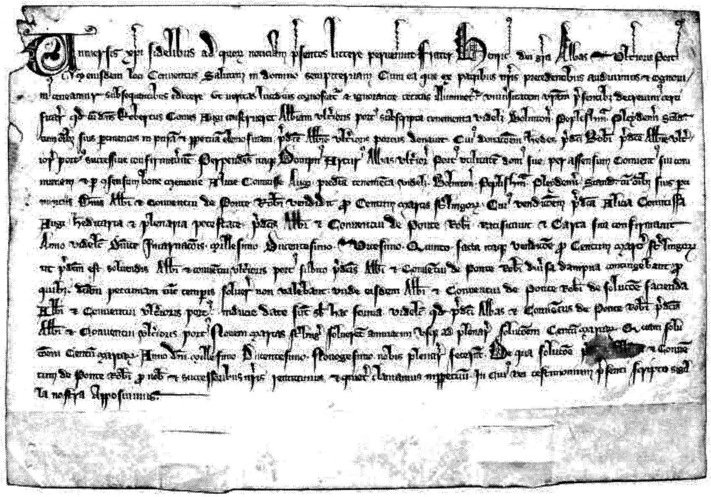

This is a certificate of payment dated 1290
Henry abbot of Tréport in Normandy to the abbot and convent of Robertsbridge; the sum of £66 13s 4d, the purchase price of tenements at Bolinton and Pebsham (Peblesham) [in Bexhill], Playden and Stand.
The Norman baron Robert, Count of Eu had supported William the Conqueror in his invasion of England by providing 60 ships for the expedition and was rewarded with the Rape of Hastings.
Robert had been responsible for the founding in 1059 of the abbey of St Michael at Tréport. His endowment of it with tenements of Sussex villages from his holdings is recited here together with subsequent confirmations of Tréport by his heirs and the sale of tenements for 100 marks to Robertsbridge abbey by Arthur, abbot of Tréport, with the consent of Alice, Countess of Eu (d,1246) who ratified the grant to Robertsbridge in 1225. Due to the inability of Robertsbridge to pay, an agreement was made in 1252 for payments of £6 per year to be made until the debt was paid off, the completion of these payments being certified by this document issued in 1290.
This document was purchased by Sussex County Records Office and Robertsbridge & District Archaeological Society were pleased to make a contribution to the purchase price.
In Search of an Abbey
This is an article probably dating from the 1960s and perhaps from Sussex Life. Please click here to view in .pdf format.
